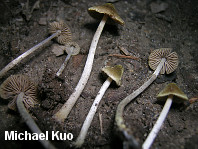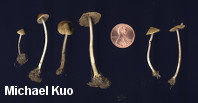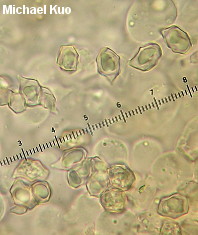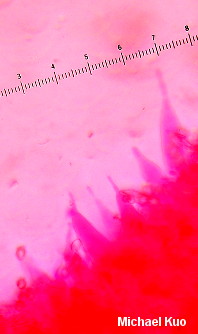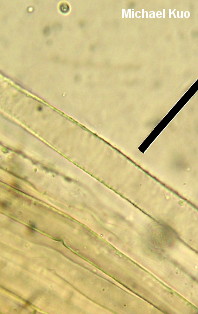| Major Groups > Gilled Mushrooms > Pink-Spored > Entolomatoid Mushrooms > Entoloma versatile |

|
Entoloma versatile [Basidiomycota > Agaricales > Entolomataceae > Entoloma . . . ] by Michael Kuo Entoloma versatile is a rare and interesting entolomatoid mushroom with a small, conic cap, reminiscent of a mycenoid mushroom or even an Inocybe. However, its pink spore print and angular spores place it definitively in Entoloma. Its cap is radially fibrillose and dark brownish olive, and its thin, whitish stem has a covering of stiff hairs near the base. It's like someone decided to shrink Tricholoma sejunctum and turn it into an Inocybe (even giving it brownish gills)--but then changed her mind and decided to give it Entoloma traits at the last second. However, it is under the microscope that Entoloma versatile really stands out: it has impressive, lageniform cheilocystidia (sterile cells on the edges of the gills) that look like half-inflated balloons with sharpened points. Entoloma versatile is a European species first named in the nineteenth century. In North America it has been reported from Washington state by Largent (1994)--and, here, from Illinois. Only one other collection labeled Entoloma versatile (or "Pouzarella versatilis," a synonym), from Iowa, shows up in a search of the nation's major herbaria at MyCoPortal. There are small differences in color, odor, and morphology of cystidia between Largent's description of Washington material, my collection (described below), and European descriptions of the species--either indicating substantial variability in the species, or that several members of a species group are involved. Description: Ecology: Saprobic; growing gregariously in bare soil under oaks and other hardwoods; fall; North American distribution uncertain (the illustrated and described collection was made in Illinois; see also the comments above about reports from Washington and Iowa). Cap: 1-2 cm; conic to broadly conic; dry; finely radially fibrillose and silky; dark brownish olive; the margin not lined. Gills: Narrowly attached to the stem; nearly distant; dull brownish at first, becoming darker brownish with a pinkish hue. Stem: 3-6 cm long; 1-3 mm thick; equal, or slightly tapered toward the apex; dry; finely fibrillose or nearly bald; whitish; discoloring brownish to yellowish near the base; base with stiff whitish hairs. Flesh: Thin; insubstantial; whitish to brownish. Odor and Taste: Odor unpleasant; taste mealy. Chemical Reactions: KOH on cap surface negative. Spore Print: Pink. Microscopic Features: Spores 7-11 x 5-7 µ; mostly 6-sided; heterodiametric; angular; smooth; hyaline. Pleurocystidia absent. Cheilocystidia abundant; mostly lageniform with a long, pointed neck, but occasionally widely fusiform or subsaccate (when collapsed); 35-65 x 12-20 µ. Pileipellis a cutis; elements brown to brownish in 10% ammonia, finely encrusted, 5-10 µ wide. Clamp connections not found. REFERENCES: (Gillet, 1876) M. M. Moser, 1978. (Moser, 1983; Noordeloos, 1988; Largent, 1994; Breitenbach & Kränzlin, 1995; Noordeloos, 2008.) Herb. Kuo 09300508. This site contains no information about the edibility or toxicity of mushrooms. |
© MushroomExpert.Com |
|
Cite this page as: Kuo, M. (2014, January). Entoloma versatile. Retrieved from the MushroomExpert.Com Web site: http://www.mushroomexpert.com/entoloma_versatile.html |
